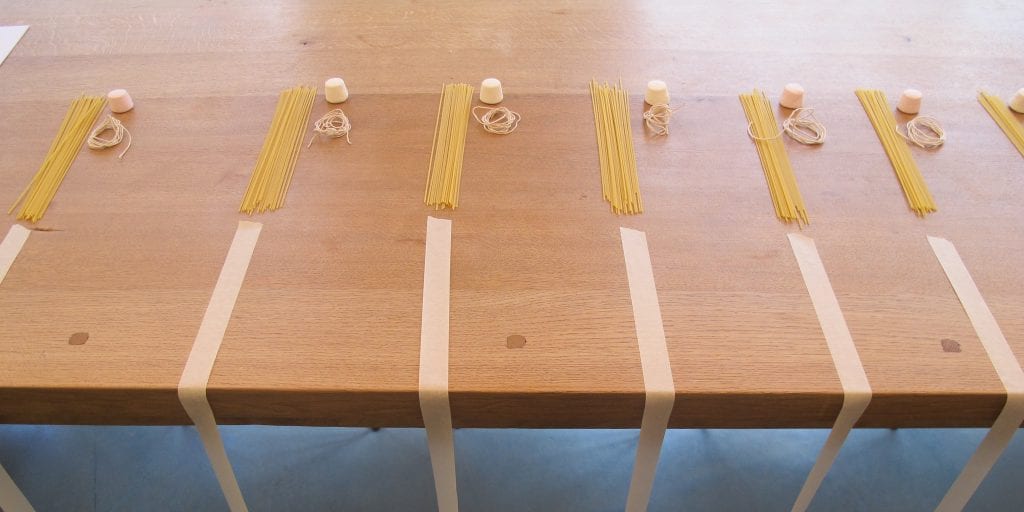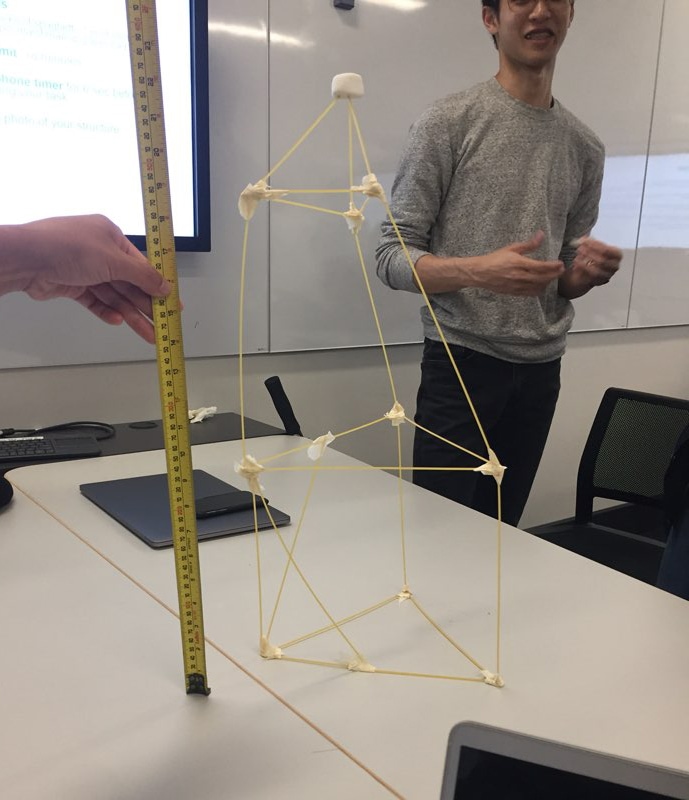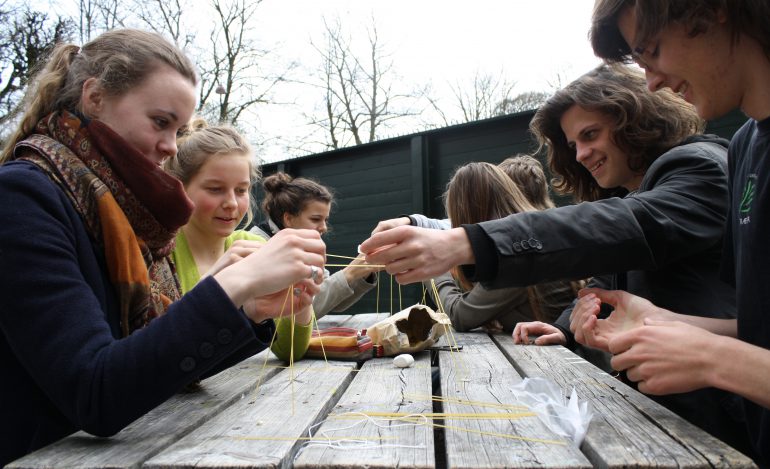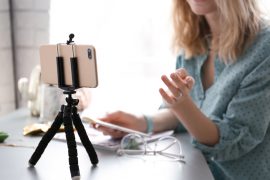Group assignments require a great deal of planning to achieve successful outcomes and prevent them from becoming a source of dissatisfaction for students. Imbalances in work on tasks, personality clashes and concerns about reaching grade targets in mixed level groups are some of the issues routinely dealt with by unit coordinators.
After receiving a number of communications from students about difficulties working with other group members, Dr Meloni Muir, Senior Lecturer in Physiology in the School of Medical Sciences, decided to incorporate a face-to-face team building activity as an icebreaker for group work in one of the units she coordinates. She discussed the idea behind it and the outcomes with Sue Atkinson from Educational Innovation.
Meloni has coordinated the second year unit of study, Physiology for Pharmacy (PHSI2601) for three years and as with many units, the group work assignments have attracted a fair share of discontent. The unit ran most recently in semester 1, 2019 with 244 students enrolled.

We academics need to put a good deal of thought and planning [into group work] to make it valuable for students.
She was introduced to a variety of team-building activities through a 2018 blended learning symposium about teamwork and reflected on whether this would be a way to engage her students in better group work outcomes. Four activities were chosen as possibilities, which Meloni tested with her small team of demonstrators.
Marshmallow Challenge
The Marshmallow Challenge was chosen for the class because the rules were simple to understand and the activity could be done in a relatively short time (20 minutes). This allowed time in the 2 hour workshop for students to use the momentum of the icebreaker to begin work on their group assignment.
Groups of 4 people are asked to use a kit containing 20 pieces of spaghetti, a metre of string, a metre of masking tape, a small paper lunch bag and one marshmallow – using any/all of the materials to build the tallest freestanding structure topped with the marshmallow. The structure must stand unaided for at least 6 seconds to be competitive.

When setting up group work tasks, Meloni allocates students to groups rather than letting them choose their membership. This is to ensure that the group composition is diverse and balanced rather than comprising all high achieving students, a group of friends or students from the same cultural background. Therefore many of the students did not know each other before being placed together in their group and taking part in the icebreaker activity.
The workshop
Meloni wanted to immerse students in thinking about team work before they started on their assignment. To open the tutorial session, she briefly introduced the graduate qualities and then she and the students spent time in the tutorial ‘unpacking’ values and assumptions around group work, as well as asking the students to discuss aspects of their previous group work experiences, both good and bad. Although ‘group work’ is the commonly used term for all non-individual assignments, Meloni makes the distinction between group work – as working independently on parts of a shared project with each member having defined roles and responsibilities – and teamwork, which she sees as a collaborative effort on multiple aspects of the task where each member is concerned about the whole outcome. She prefers to guide students into a team work model.
Next in the session, the potential benefits of team work were discussed, which include:
- diverse views lead to a better outcome
- teams contain a more rounded skill set than an individual’s
- results are achieved quicker than working alone
- team members can learn from each other – about the topic and about themselves
- working in teams helps develop the students’ graduate qualities and is authentic experience in preparation for work
The Marshmallow Challenge activity was run and afterwards Meloni facilitated a debrief where the newly formed teams were asked to identify one thing that contributed to their Marshmallow Challenge outcome. The discussion moved on to the group assignment, asking students to identify the mark that they were aiming for, which exposed differing goals and assumptions.
Team members then worked together to establish written ‘ground rules’ for the way their team would work together to complete the group assignment and handle any difficulties. This became the first entry on their Canvas group page that could be referred to in the weeks that followed, as they worked together and negotiated relationships and tasks.
Student response and outcomes

During the Marshmallow Challenge activity the room was noisy, joyful and energised. Meloni was surprised by the evenness of the participation in the activity. The student cohort was very diverse, but even quiet students were actively engaged and giving verbal input. The activity fulfilled the goal of student-centred learning that Meloni holds for tutorials.
I want students to be the vocal ones during prac, rather than the teachers.
The activity allowed students to relax and ‘find their voices’ and Meloni found that they maintained the high level of engagement throughout semester. She believes that the icebreaker helped to build an atmosphere of collaboration in learning generally, not just in the group work task. Other changes she observed after the activity were more egalitarian groups with members questioning others’ ideas and working to reach consensus, rather than more dominant individuals having their ideas accepted without debate. For the first time during a semester she did not receive any complaints at all from students about their groups.
In the first two years she taught the unit, students tended to divide up the group work task between the members and then compile the parts but after doing the icebreaker activity, she found that the students worked in a more integrated way that was closer to a teamwork model.
Part of the assignment involves giving peer feedback to members of the group. This year after the icebreaker was introduced, Meloni also observed that students gave more text-based feedback to group members in their peer assessments than in other years.
During evaluation of the unit, students were asked whether they would recommend the icebreaker to be run with future students. They unanimously agreed that it should. In answer to the question about whether the activity had value beyond being fun, the students said the activity made it easier to talk with group members – generally and about difficult topics – and easier to create the ground rules for the upcoming group work activity. Students recognised the value of the group work they had done for their future careers and were thinking in terms of developing graduate qualities – something they hadn’t done before.
Tips for success
What made the activity so successful?
- Meloni worked to clarify the learning outcomes and benefits of group work, offered ways of thinking about it, set clear expectations and helped students to reflect on their learning.
- She discussed the importance of the University’s graduate qualities with students, explaining that it was part of the mission of units of study to help them develop them and explained how working in a team on this assignment would contribute.
- She gently exposed potential differences in values and perception between group members before conflict occurred, so they saw the need to negotiate agreed guidelines on how they would work together.
- She showed how constructive peer feedback could assist students to see their contributions from other points of view and guided them to see that the entire group experience was an opportunity to help each other grow and learn.
It is important that the activity, as with icebreakers for online discussion boards, is not related to the unit of study content and therefore is no/low stakes in terms of marks and status.
Student thoughts
The students provided thoughts on what made a successful group work activity during their debrief period. They identified:
- listening to one another,
- everyone talking and participating, and;
- building on one another’s ideas
as the key ingredients to group work success.
Impact on teaching assistants
Did testing the Marshmallow Challenge activity have positive outcomes for the demonstrators too? Meloni believes that the insights they gained from doing the teamwork activity, including some of the difficulties (they reflected that they could have listened to each other more actively) gave them greater insight into the student perspective. This improved communication between the demonstrators and students during semester.
Resources
Marshmallow Challenge Facilitator Guide – Toastmasters International
Build a Tower, Build a Team – Tom Wujec’s TED talk on what he learned from doing the activity with groups ranging from engineers and CEOs to kindergarten students.





